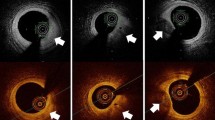Abstract
Frequency domain optical coherence tomography (FD-OCT) has shown promise to evaluate coronary devices in clinical trials, however, little is known about its application in clinical practice. This prospective, single center initiative planned for 100 % FD-OCT utilization in all patients undergoing coronary interventions during a 60-day period. Operators pre-specified the planned intervention based on angiography alone. FD-OCT success was defined as acquisition of good quality images enabling adequate quantification of vessel dimensions and lesion/percutaneous coronary intervention (PCI) assessment. Impact on management occurred when angiography-based planning was altered based on FD-OCT data. There were 297 FD-OCT acquisitions performed in 155 vessels from 150 patients. There were no FD-OCT procedural related cardiac adverse events and success was obtained in 85.7 % of all target vessels (pre-PCI = 76.8 % vs. post-PCI = 90.1 %, p = 0.004). Success on the first pullback occurred in 80.3 % overall (61.9 % in the initial operator experience and 85.5 % after the third procedure). FD-OCT impact on management was 81.8 % pre-PCI and 54.8 % post-PCI. Stent malapposition was detected in 39.2 % (89.4 % underwent further intervention) and edge dissection in 32.5 % (21.1 % treated with stent). FD-OCT success and management impact were similar in ACS and non-ACS patients (82.1 vs. 81.1 %, p = 1.000, and 62.5 vs. 65.1 %, p = 0.854, respectively). FD-OCT is safe, can successfully be incorporated into routine practice, and alters procedural strategy in a high proportion of patients undergoing PCI.


Similar content being viewed by others
References
Bezerra HG, Costa MA, Guagliumi G et al (2009) Intracoronary optical coherence tomography: a comprehensive review. JACC Cardiovasc Interv 2:1035–1046
Yabushita H, Bouma BE, Houser SL et al (2002) Characterization of human atherosclerosis by optical coherence tomography. Circulation 106:1640–1645
Jang IK, Bouma BE, Kang DH et al (2002) Visualization of coronary atherosclerotic plaques in patients using optical coherence tomography: comparison with intravascular ultrasound. J Am Coll Cardiol 39:604–609
Jang IK, Tearney GJ, MacNeill B et al (2005) In vivo characterization of coronary atherosclerotic plaque by use of optical coherence tomography. Circulation 111:1551–1555
Kume T, Akasaka T, Kawamoto T et al (2006) Assessment of coronary arterial plaque by optical coherence tomography. Am J Cardiol 97:1172–1175
Tanigawa J, Barlis P, Dimopoulos K, Di Mario C (2008) Optical coherence tomography to assess malapposition in overlapping drug eluting stents. EuroIntervention 3:580–583
Gonzalo N, Garcia–Garcia HM, Serruys PW et al (2009) Reproducibility of quantitative optical coherence tomography for stent analysis. EuroIntervention 5:224–232
Guagliumi G, Sirbu V, Bezerra H et al (2010) Strut coverage and vessel wall response to zotarolimus-eluting and bare-metal stents implanted in patients with ST-segment elevation myocardial infarction: the OCTAMI (optical coherence tomography in acute myocardial infarction) Study. JACC Cardiovasc Interv 3:680–687
Guagliumi G, Musumeci G, Sirbu V et al (2010) Optical coherence tomography assessment of in vivo vascular response after implantation of overlapping bare-metal and drug-eluting stents. JACC Cardiovasc Interv 3:531–539
Prati F, Regar E, Mintz GS et al (2010) Expert review document on methodology, terminology, and clinical applications of optical coherence tomography: physical principles, methodology of image acquisition, and clinical application for assessment of coronary arteries and atherosclerosis. Eur Heart J 31:401–415
Ellis SG, Vandormael MG, Cowley MJ et al (1990) Coronary morphologic and clinical determinants of procedural outcome with angioplasty for multivessel coronary disease. Implications for patient selection. Circulation 82:1193–1202
Imola F, Mallus MT, Ramazzotti V et al (2010) Safety and feasibility of frequency domain optical coherence tomography to guide decision making in percutaneous coronary intervention. EuroIntervention 6:575–581
Barlis P, Gonzalo N, Di Mario C et al (2009) A multicentre evaluation of the safety of intracoronary optical coherence tomography. EuroIntervention 5:90–95
Rihal CS, Textor SC, Grill DE et al (2002) Incidence and prognostic importance of acute renal failure after percutaneous coronary intervention. Circulation 105:2259–2264
Prati F, Cera M, Ramazzotti V et al (2007) Safety and feasibility of a new non-occlusive technique for facilitated intracoronary optical coherence tomography (OCT) acquisition in various clinical and anatomical scenarios. EuroIntervention 3:365–370
Roy P, Steinberg DH, Sushinsky SJ et al (2008) The potential clinical utility of intravascular ultrasound guidance in patients undergoing percutaneous coronary intervention with drug-eluting stents. Eur Heart J 29:1851–1857
Kawamori H, Shite J, Shinke T et al (2010) The ability of optical coherence tomography to monitor percutaneous coronary intervention: detailed comparison with intravascular ultrasound. J Invasive Cardiol 22:541–545
Ozaki Y, Okumura M, Ismail TF et al (2010) The fate of incomplete stent apposition with drug-eluting stents: an optical coherence tomography-based natural history study. Eur Heart J 31:1470–1476
Bouma BE, Tearney GJ, Yabushita H et al (2003) Evaluation of intracoronary stenting by intravascular optical coherence tomography. Heart 89:317–320
Virmani R, Burke AP, Farb A, Kolodgie FD (2006) Pathology of the vulnerable plaque. J Am Coll Cardiol 47(Suppl):C13–C18
Stone GW, Maehara A, Lansky AJ et al (2011) A prospective natural-history study of coronary atherosclerosis. N Engl J Med 364:226–235
Acknowledgments
The authors would like to thank the following individuals for their participation in this project: Agustus A. Beck, M.D., Shyam Bhakta, M.D., Michael J. Cunningham, M.D., Joseph Jozic M.D., Tom A. Lassar, M.D., Mohammed N. Osman, M.D., Sahil A. Parikh, M.D., Noah Rosenthal M.D., William Wolf M.D., and David A. Zidar, M.D., Ph.D.
Conflict of interest
Dr. Bezerra reports receiving honoraria/research grants from St. Jude Medical. Dr. Costa is on the Speaker’s Bureau and is a consultant for BSC, Sanofi/Aventis, Eli Lilly, and Medtronic and is on the Speaker Bureau and a member of the Scientific Advisory Board for Abbott, Cordis, St. Jude Medical and Scitech. Dr. Simon is a member of advisory boards for Cordis/Johnson & Johnson, Medtronic Vascular, and Daiichi Sankyo. Dr. Stefano is a consultant for St. Jude Medical.
Author information
Authors and Affiliations
Corresponding author
Rights and permissions
About this article
Cite this article
Stefano, G.T., Bezerra, H.G., Mehanna, E. et al. Unrestricted utilization of frequency domain optical coherence tomography in coronary interventions. Int J Cardiovasc Imaging 29, 741–752 (2013). https://doi.org/10.1007/s10554-012-0135-0
Received:
Accepted:
Published:
Issue Date:
DOI: https://doi.org/10.1007/s10554-012-0135-0




